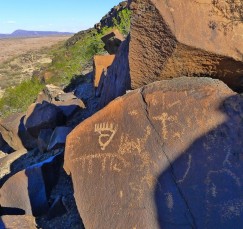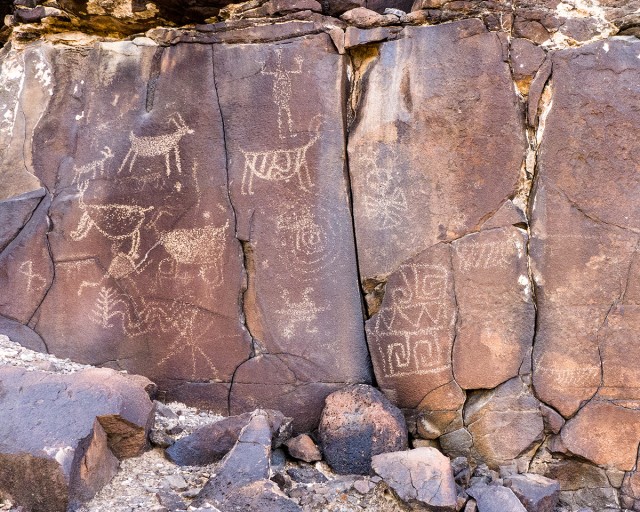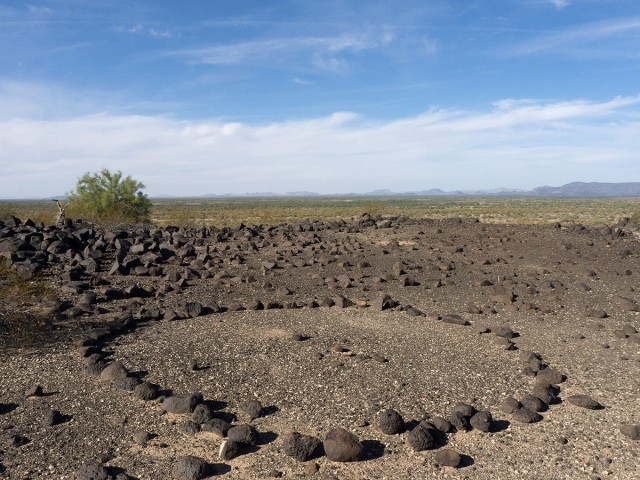- Home
- >
- Press Releases/Announcements
- >
- Archaeology Southwest Acquires a Portion of Quail ...
New Protection for Ancient Rock Art

Southern Arizona-based nonprofit Archaeology Southwest acquires a 360-acre parcel at Quail Point, an exceptional rock art site in the Gila Bend region
Tucson, Ariz. (July 29, 2014) — Protection of millennia-old rock art in the Gila Bend region of Arizona was strengthened when heritage preservation organization Archaeology Southwest recently acquired a 360-acre parcel that includes a large portion of Quail Point, an impressive rock art site within the proposed Great Bend of the Gila National Monument. The Bureau of Land Management (BLM) administers the other portion. Through Archaeology Southwest’s ownership of the parcel—which comprises a significant cluster of rock art, segments of ancient trails, and part of a seasonal camp inhabited by people of the Patayan culture about a thousand years ago—the organization will routinely monitor conditions of the archaeological resources on the parcel. Archaeology Southwest will also provide research and educational access aligned with heritage conservation goals.
“Quail Point is one of the most notable sites along the Great Bend of the Gila River because it features two major concentrations of petroglyphs,” explains Andy Laurenzi, Archaeology Southwest’s Field Representative for site protection. “Through this acquisition, we’ll be protecting a significant portion of one of the petroglyph clusters.”
Petroglyphs are images carved or abraded into stone. Other forms of rock art found in the region include pictographs, images created by brushing, finger-painting, or blowing moistened soot or pigments onto rock, and geoglyphs, large designs or patterns made by aligning rocks on the ground surface. Because of its distinctive volcanic geology, the Great Bend of the Gila River is rich with such fragile—and endangered—traces of ancient life.

“The petroglyphs at Quail Point, nearby Sears Point, and other locations along this riverine corridor are so impressive that rock art expert Ekkehart Malotki and others have told me that together, these places merit designation as a World Heritage Site,” Laurenzi continues. “I hope that through controlled access and diligent monitoring of our parcel, we can prevent the vandalism toward rock art that is all too common—spray paint, bullet holes, new carvings and abrasions.”
The BLM-managed portions of Quail Point and other places of ancient human endeavor in the Gila Bend region are, collectively, a candidate for additional federal protection as a national monument. In March 2013, Congressman Raúl Grijalva introduced a package of bills that included the Great Bend of the Gila National Monument Establishment Act. The Act seeks to manage and preserve an 84,000-acre area on public lands along the Gila River, from Robbins Butte in Maricopa County to Sears Point in Yuma County, as an integrated cultural landscape.
With Archaeology Southwest as its Local Partner, the National Trust for Historic Preservation has taken up the cause, adding the Great Bend of the Gila to its National Treasures program. That program is a platform for promoting federal protection of places of national significance. “National monument status would bring a higher level of protection, management, and funding than what the Bureau of Land Management is able to provide for the cultural and natural resources it currently manages in the region,” says Bill Doelle, Archaeology Southwest’s President and CEO. “The Great Bend of the Gila is a cultural crossroads with a deep, rich, often overlooked past. Our role on the coalition—and now as a landowner—is to raise awareness of the truly unique, nonrenewable resource that is the cultural landscape of the Great Bend, and show why it warrants national monument status.”
For thousands of years, the Gila River in this area sustained the lives of travelers and residents alike, and the astounding rock art is just one expression of that story. The river was essential to an extensive ancient trail network, Hohokam and Patayan settlements, European explorations, Euro-American stagecoach routes, homesteaders and ranchers, and early twentieth-century cross-country motorists.
“Our acquisition of the parcel at Quail Point reaffirms our commitment to long-term protection of the incredible natural and archaeological resources of the Great Bend,” states Doelle. “As landowners with a conservation-based mission, we are even further invested in the future of its history.”

About Archaeology Southwest
Archaeology Southwest is a private 501(c)(3) nonprofit organization based in Tucson, Arizona, that explores and protects the places of our past across the American Southwest and Mexican Northwest. For three decades, Archaeology Southwest has practiced a holistic, conservation-based approach known as Preservation Archaeology. By exploring what makes a place special, sharing this knowledge in innovative ways, and enacting flexible site protection strategies, we foster meaningful connections to the past and respectfully safeguard its irreplaceable resources. Learn more at https://www.archaeologysouthwest.org.
###
One thought on “Archaeology Southwest Acquires a Portion of Quail Point”
Comments are closed.
Explore the News
-
Join Today
Keep up with the latest discoveries in southwestern archaeology. Join today, and receive Archaeology Southwest Magazine, among other member benefits.
Sacred land. Thank you for helping to preserve it.